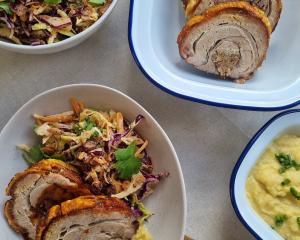It's Mardi Gras time in New Orleans. People get dressed up and dance and catch beads. They also eat. They might also travel to the other southern states, where they will also eat. Debbie Porteous finds they will encounter a mixed bag - but they won't go hungry.
Underneath the crispy batter, ham, turkey and two cheeses oozed from between layers of soft white bread.
The icing sugar sprinkled on its outside, strangely, did not detract from its taste.
"We won national prizes with that thing,'' the proud cook screamed across the food truck park in deepest Austin.
This, our vegetarian guide tells us, is some good Texan fare.
Our glamorous Australian companion had ordered the prawn skewers.
They arrived nestled on sticks in a small plastic carton.
They came with a bigger carton filled with creamy white slaw, and a massive carton filled with hot fries.
Our companion worked at a women's magazine. She nibbled at some prawns.
By that night, on our third day in the smothering Texas heat, she was not the only one desirous of something fresh and batter or sauce-free.
Breakfast that day had been a feast of Tex-Mex delights, colourful huevos rancheros with bright green avocados and creamy red sauce, and soft scrambled egg tacos with chilli sauce.
The night before, we had scoffed giant fillets of prime Texan beef on beds of smoked blue corn grits in small order, while magazine girl tucked into a cornbread-stuffed spatchcocked quail.
We kidded ourselves that a plateful of blistered sweet shishito peppers, which we initially feared might be the world's spiciest chillis, provided some vegetable intake.
But it had been that day's lunch that was the real eye-opener.
As we forced our way through the thick air to a slightly grubby red shack in the bowels of Houston, we could smell it coming. It was barbecue.
Our proprietor, Misty, looms large at one end of a table heaped with kilograms of charred meat and side dishes, explaining just how big the southern tradition of barbecue is.
It has really become a southern movement, she says, and the Houston scene in particular is "charging''.
We agree it is good as we lick our half-kilo ribs clean.
Each region of each southern state has its preferred rubs, meats and cuts, and ways of cooking them, Misty says.
"This is Texas and people are going to eat beef.''
Misty and Russell Roegels do their barbecue the "old-fashioned central Texas way'', the long smoke.
Brisket and ribs are most popular in Houston.
All are smothered in a secret (many trademarked) recipe rub and smoked in oak-fired steel "pits'' for up to 14 hours at 135degC.
The smell is overwhelming.
"Russell says our kids came out smelling like barbecue,'' says Misty.
It's not barbecue without a helping of pimento beans, coleslaw and Mac 'n Cheese - the only side not made in-house because "we just can't get the cheeses to melt together like that''.
Washing it down with cold sweet tea, we feel full and happy.
Our eyes are opened wider than even our mouths to the possibilities of meat.
That night we look forward to the "modern Creole'' menu at Underbelly in one of Houston's hipper neighbourhoods, but fear more meat, as the restaurant's name implies.
Happily we are disappointed on that front, as fresh ingredients and lighter preparations appear one after the other.
Fresh from the city's Asian and farmers' markets and delis, it is a big "yay'' for al dente Korean braised goat with dumplings and crunchy sweet grilled cantaloupe with smoked ricotta.
Two whole gropers with crispy crusts happily clinging on to one another over a salad of Asian greens bring oohs and ahs, helped along not a little by a generous host's not insignificant selection of American and French wines to match.
Naturally, there was a room, in the corner of the restaurant, hung full of meat.
We can see through its big glass windows the bodies and limbs of animals slowly drying up. It is the house charcuterie, where meats are hung to age and cure.
Most southern menus offer a version of a usually pork-ridden cured meat platter that is, for the lover of a cornichon and pate, most welcome.
If curing is a popular technique of food preparation in the southern states, it is well and truly trumped by deep-frying.
At Houston's The Breakfast Klub (yes, you are likely to wait at least 30 minutes in the queue, but bear with ...) you just know you are in for a treat when you see the happy faces of the families and friends jostling and laughing inside as they tuck into their enormous helpings of deep-fried catfish with grits and a biscuit, or wings and waffles.
Read it.
That is deep-fried chicken wings with sweet waffles and smooth maple syrup.
On top of each other.
Helped down by half a litre of strong black coffee.
Order it, try a wing, see how much you can get through.
The food excitement builds as we fly into New Orleans, Louisiana, the home of shrimp, crawfish, oysters, alligators and turtles.
You can eat them all and Lousianians do.
Spanish and Mediterranean influences might lead one to expect some spice and heat in New Orleans' food, but we are largely disappointed in that respect.
The city lacks not, however, for good street food and there are salty oysters, meaty, cheesy po' boys, sickly sweet pralines and meat-stuffed muffaletta sandwiches on nearly every corner.
At a restaurant that was called Pig, but in French, we learn alligator tastes a bit like chicken.
While there are many famous, must-visit restaurants in New Orleans, it is hard to go past Mother's Restaurant in Pydras St.
It has its own language.
"We speak baby, darling and sweetheart'', says the menu, which comes with a mini-dictionary so people know what they are ordering.
Its specialty is baked ham, as well as "debris'', which they helpfully define on the menu as "the roast beef that falls into the gravy while baking in the oven''.
The queue is quick and the place is packed.
You want Jambalaya, shrimp creole, a meat biscuit, crawfish etouffee or a bread pudding with red beans and rice?
They've got it.
We choose the "Ferdi special'' po' boy, a sub stuffed full with baked ham, roast beef, debris, jus (gravy) and a small bowl of gumbo.
Sadly, the stew-like chicken gumbo is spiceless, but as we chew, and chew, the stringy beef of our slightly soggy po-boy, a group of children at another table bursts into song so lovely it even quiets the din from the tableful of Baptist pastors next to us.
And there it is.
Southern comfort and southern food, all in one slightly messy, exceptionally popular, apparently, package.
As the menu at Mother's says, "why mess with success''?
● The writer travelled to the United States courtesy of Air New Zealand.
Eight things to try in New Orleans
• Muffaletta sandwich. Get it at the original source, the sandwich counter at Central Grocery on Decatur St in the French Quarter.
• Praline - cream, sugar and pecans, how can you go wrong?
• Oysters - fried, fresh, grilled, in a soup, on every other corner in the French Quarter.
• Po' Boys. Experience Mother's, or get one and go at Johnny's Po-Boys (St Louis St).
• Fried alligator and crawfish salad at Cochon Restaurant, Tchoupitoulas St.
• Beignet and latte. Always good, available widely.
• A Sazerac - yes, a drink. It's dry, it's a whisky cocktail. It's New Orleans in a glass. Try it at the Sazerac Bar at the Roosevelt New Orleans Hotel (Roosevelt Way) and feel old-worldy and glamorous.
• A snowball from Hansen's Sno-Bliz in Tchoupitoulas St. Soft shaved ice and silky syrup. Because it's hot out there.
A southern glossary
Po' Boy
The name po' boy refers to sandwiches served to ‘‘poor boys'' during a four-month long streetcar strike in 1929. Across town, Benny and Clovis Martin, who were once streetcar conductors, offered sandwiches out of sympathy from the back door of their restaurant.
Because the strikers were too poor to pay, they were made from scraps of roast beef in hot gravy ladled over fried potatoes and served on loaves of New Orleans French bread.
Grits
A sort of savoury porridge made by boiling ground corn.
Biscuits
A sugarless savoury quick bread, similar to a scone, served with gravy usually.
Creole and Cajun
Essentially, Creole cuisine uses tomatoes and proper Cajun food does not. The terms really apply to where the food originated from; some say Creole cuisine refers to city food, and cajun cuisine to country food. Creole and Cajun are two different cultures.
Gumbo
Gumbo is a stew that originated in southern Louisiana during the 18th century. It consists primarily of a strongly flavoured stock, meat or shellfish, a thickener, and celery, bell peppers and onions.
Jambalaya
Meat, usually chicken and/or sausage such as andouille or smoked sausage, is added to vegetables, tomatoes and seafood. Rice and stock are added.
Barbecue
Meat cooked "slow and low'' in a wood-fired pit, usually smoked and with a rub applied.
Charcuterie
Branch of cooking devoted to prepared meat products, such as bacon, ham, sausage, terrines, galantines, ballotines, pates and confit, primarily from pork.











